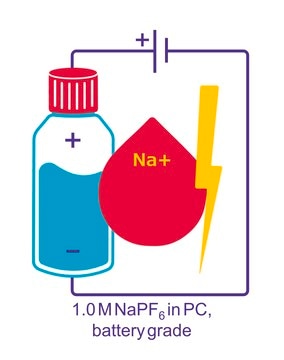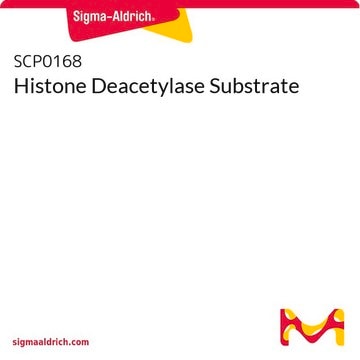EPI004
Histone Deacetylase 3 (HDAC3) Activity Assay Kit
100 assays in 96 well plates
Synonyme(s) :
Histone deacetylase assay
Se connecterpour consulter vos tarifs contractuels et ceux de votre entreprise/organisme
About This Item
Produits recommandés
Utilisation
100 assays in 96 well plates
Numéro d'accès NCBI
Conditions d'expédition
wet ice
Température de stockage
−20°C
Informations sur le gène
human ... HDAC3(8841)
mouse ... HDAC3(15183)
Description générale
Histone deacetylases (HDACs) are a large family of enzymes that remove acetyl groups from histone proteins. Site specific histone acetylation and deacetylation have been shown to activate or repress eukaryotic gene transcription, respectively, and as a consequence, it plays a crucial role in mammalian development and disease. HDACs are involved in important biological activities, such as cell differentiation, proliferation, apoptosis, and senescence.
With Sigma′s HDAC3 Activity Assay Kit, HDAC3 present in a test sample will act with the supplied Developer, to deacetylate and then cleave the HDAC3 Substrate [R-H-K-K(Ac)-AFC]. This activity will release the quenched fluorescent group, AFC, which can be detected at Em/Ex = 380/500 nm. Trichostatin A is an HDAC inhibitor included in the kit to verify HDAC3 activity. The kit provides a rapid, simple, sensitive and reliable test. It is suitable for either individual tests or high throughput assays, from nuclear extracts, purified, or immunoprecipitated HDAC3, and from native, recombinant, or genetically modified HDAC3.
With Sigma′s HDAC3 Activity Assay Kit, HDAC3 present in a test sample will act with the supplied Developer, to deacetylate and then cleave the HDAC3 Substrate [R-H-K-K(Ac)-AFC]. This activity will release the quenched fluorescent group, AFC, which can be detected at Em/Ex = 380/500 nm. Trichostatin A is an HDAC inhibitor included in the kit to verify HDAC3 activity. The kit provides a rapid, simple, sensitive and reliable test. It is suitable for either individual tests or high throughput assays, from nuclear extracts, purified, or immunoprecipitated HDAC3, and from native, recombinant, or genetically modified HDAC3.
Caractéristiques et avantages
- Simple, sensitive, and reliable assay
- Simple procedure; takes ~60 min
- Utilizes fluorometric methods
- Sample type: cell and tissue lysates, plasma and serum, other biological fluids
- Species reactivity: mammalian
- Suitable for individual tests or high throughput assays and kinetic studies
- Convenient 96-well microplate format
- Suitable for high throughput measurement of HDAC3 activity in purified, immunoprecipitated and recombinant or genetically modified HDAC3 samples
Produit(s) apparenté(s)
Réf. du produit
Description
Tarif
Code de la classe de stockage
10 - Combustible liquids
Classe de danger pour l'eau (WGK)
WGK 3
Point d'éclair (°F)
188.6 °F - closed cup
Point d'éclair (°C)
87 °C - closed cup
Certificats d'analyse (COA)
Recherchez un Certificats d'analyse (COA) en saisissant le numéro de lot du produit. Les numéros de lot figurent sur l'étiquette du produit après les mots "Lot" ou "Batch".
Déjà en possession de ce produit ?
Retrouvez la documentation relative aux produits que vous avez récemment achetés dans la Bibliothèque de documents.
Karolina J Janczura et al.
Proceedings of the National Academy of Sciences of the United States of America, 115(47), E11148-E11157 (2018-11-07)
Alzheimer's disease (AD) is the leading cause of age-related dementia. Neuropathological hallmarks of AD include brain deposition of β-amyloid (Aβ) plaques and accumulation of both hyperphosphorylated and acetylated tau. RGFP-966, a brain-penetrant and selective HDAC3 inhibitor, or HDAC3 silencing, increases
Hai-Ying Zhu et al.
Biochemical and biophysical research communications, 444(4), 638-643 (2014-02-05)
Interspecies somatic cell nuclear transfer (iSCNT) is a promising method to clone endangered animals from which oocytes are difficult to obtain. Monomeric red fluorescent protein 1 (mRFP1) is an excellent selection marker for transgenically modified cloned embryos during somatic cell
Li-Sophie Z Rathje et al.
Proceedings of the National Academy of Sciences of the United States of America, 111(4), 1515-1520 (2014-01-30)
Oncogenes deregulate fundamental cellular functions, which can lead to development of tumors, tumor-cell invasion, and metastasis. As the mechanical properties of cells govern cell motility, we hypothesized that oncogenes promote cell invasion by inducing cytoskeletal changes that increase cellular stiffness.
Q Yang et al.
Cell proliferation, 46(6), 654-664 (2014-01-28)
Pulmonary arterial hypertension, characterized by pulmonary vascular remodelling and vasoconstriction, is associated with excessive proliferative changes in pulmonary vascular walls. However, the role of HDACs in the phenotypic alteration of pulmonary arterial smooth muscle cells (PASMC) is largely unknown. Pulmonary
Bihua Bie et al.
Nature neuroscience, 17(2), 223-231 (2014-01-21)
Amyloid-induced microglial activation and neuroinflammation impair central synapses and memory function, although the mechanism remains unclear. Neuroligin 1 (NLGN1), a postsynaptic protein found in central excitatory synapses, governs excitatory synaptic efficacy and plasticity in the brain. Here we found, in
Notre équipe de scientifiques dispose d'une expérience dans tous les secteurs de la recherche, notamment en sciences de la vie, science des matériaux, synthèse chimique, chromatographie, analyse et dans de nombreux autres domaines..
Contacter notre Service technique








